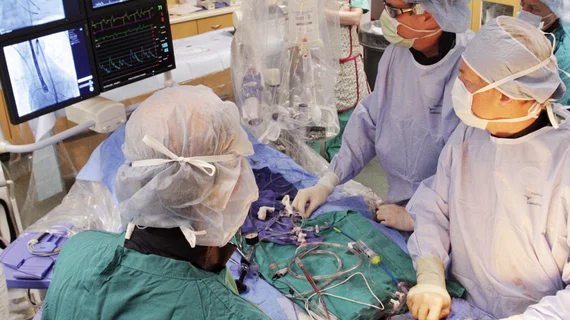Transcatheter aortic valve replacement (TAVR) patients presenting with peripheral artery disease (PAD) may face a heightened risk of in-hospital adverse events, including mortality, according to new findings published in Current Problems in Cardiology.[1]
“PAD affects up to 8.5 million people in the United States and over 230 million people worldwide, with symptoms ranging from chronic pain to limb-threatening ischemia,” wrote first author Waqas Ullah, MD, a specialist with Thomas Jefferson University Hospital in Philadelphia, and colleagues. “It is markedly prevalent in the elderly population, affecting over 20% of those aged 80 years and older in the U.S. Owing to similar pathophysiologic mechanisms and overlapping risk factors (age, smoking, hypertension, diabetes, and dyslipidemia), PAD coexists with other diseases such as aortic valve stenosis. This explains why PAD is frequently found among patients undergoing TAVR with a reported prevalence of 20-30% worldwide.”
Research on how PAD can affect TAVR outcomes remains limited. Hoping to provide some more clarity on this topic, researchers examined data from nearly 15,000 PAD patients who underwent TAVR in the U.S. from 2015 to 2019. All data came from the National Readmissions Database.
While 49.4% of patients included in the study presented with PAD, the remaining 50.6% were free of PAD. Patients with PAD were more likely to be female. This group was also more likely to present with hypertension or congestive heart failure.
Overall, PAD was linked to “significantly higher” unadjusted odds of net adverse clinical events (NACEs), in-hospital mortality, major bleeding events and cardiogenic shock.” The study’s authors also performed a propensity score matching (PSM) analysis, noting that PAD was still associated with a higher risk of in-hospital NACE (5.1% vs. 3.3%) or in-hospital mortality (2.1% vs. 0.5%). In the PSM, however, there were no longer significant differences in the rates of major bleeding events and cardiogenic shock.
In addition, the authors noted, PAD patients undergoing TAVR appeared to face a much higher risk of mortality if they were older than 65 years old or female.
Higher in-hospital risk of NACE in TAVR patients with PAD
What, exactly, is to blame for these significant differences in TAVR outcomes among PAD patients? Ullah et a. detailed some potential explanations.
“The higher in-hospital risk of NACE in patients with PAD was driven by the greater incidence of TAVR-related all-cause mortality,” they wrote. “The probable mechanisms for these observations could be due to increased use of alternative access, including the use of the transapical route in patients with PAD. While this strategy might play a role in preventing minor vascular complications, it can have detrimental effects on survival, and raises the question of whether a more aggressive approach to treating PAD percutaneously prior to TAVR may offer a better strategy compared with non-transfemoral or subclavian alternative access routes. The worse clinical outcomes in PAD are likely secondary to higher risk of access site complications, and concomitant manifestations of systemic atherosclerosis such as coronary artery disease, cerebrovascular disease, and chronic renal failure, all of which are known to be associated with worse in-hospital outcomes after TAVR.”
Physical activity may also be limited among certain PAD patients, the authors added. This increases the risk of frailty, which can lead to a higher risk of ischemic events or hospital readmissions.
“Overall, the higher in-hospital mortality in the PAD group is likely due to accumulation of multiple risk factors, frailty, old age and selection of a sicker cohort,” the authors wrote.
The promising news: TAVR outcomes even out over time
Another key takeaway from the team’s analysis was that in-hospital outcomes appear to be the only ones significantly impacted by PAD. After 180 days, for instance, mortality rates are similar between TAVR patients who presented with and without PAD.
“This could imply that the immediate post-procedural period in patients with PAD is the most critical time and can be a major determinant of survival,” they authors wrote. “However, with better post-TAVR care, once the procedure-related comorbidities are largely overcome, survivors of the index admission might have similar outcomes as non-PAD patients.”
Read the full study here.

